Overview
Managing Type 2 diabetes can feel overwhelming, but you're not alone in this journey. To take control effectively, it's important to embrace a combination of lifestyle changes, medication management, and regular blood sugar monitoring. Consider the power of maintaining a healthy diet and engaging in physical activity. These steps not only support your health but also help you feel more in control.
Adhering to prescribed medications, such as Metformin, is crucial. It's understandable to have questions about your treatment plan, and staying informed can make a significant difference. Consistently monitoring your glucose levels is another key strategy that can lead to better health outcomes.
Remember, you have the support you need. By making these changes, you can achieve a healthier lifestyle and improve your overall well-being. We are here to support you every step of the way. If you have any concerns or need guidance, don’t hesitate to reach out for resources that can help you navigate this journey.
Introduction
Understanding the complexities of Type 2 Diabetes is crucial in a world where this condition affects millions. It's important to recognize that nearly 90% of diabetes cases are Type 2, highlighting the urgent need for effective management strategies. This article explores essential steps that empower you to take control of your health.
From recognizing symptoms to implementing lifestyle changes and utilizing medication wisely, we aim to provide you with the information you need.
As you embark on this journey, it's understandable to wonder: how can you navigate the challenges of managing this condition while striving for a healthier, more fulfilling life?
Understand Type 2 Diabetes: Definition and Causes
Diabetes mellitus type 2 is a long-lasting condition primarily characterized by insulin resistance, which means the body struggles to use insulin efficiently, resulting in elevated blood sugar levels. This condition is often influenced by factors such as obesity, physical inactivity, and genetics. It’s important to note that nearly 90% of individuals diagnosed with diabetes are identified as having type 2, highlighting its prevalence.
Obesity significantly increases the risk of developing insulin resistance, making weight management a vital aspect of blood sugar regulation. For example, one inspiring case study showcased a 62-year-old individual who successfully reversed his Type 2 Diabetes in just 30 days through dedicated lifestyle changes. This underlines the potential for improvement with proactive steps.
Recent studies in 2025 have further established a direct connection between obesity and insulin resistance, underscoring the importance of mindful dietary choices and regular physical activity in managing blood sugar levels. By recognizing these factors and their impacts, you can take informed actions toward better health outcomes in your journey to learn how do you control type 2 diabetes.
At T2DSolutions, we believe in a holistic approach to diabetes care. We encourage lifestyle changes and provide community support to empower individuals on their health journeys. We are here to support you every step of the way, making T2DSolutions an essential resource for those newly diagnosed with type 2 and type 3 diabetes.
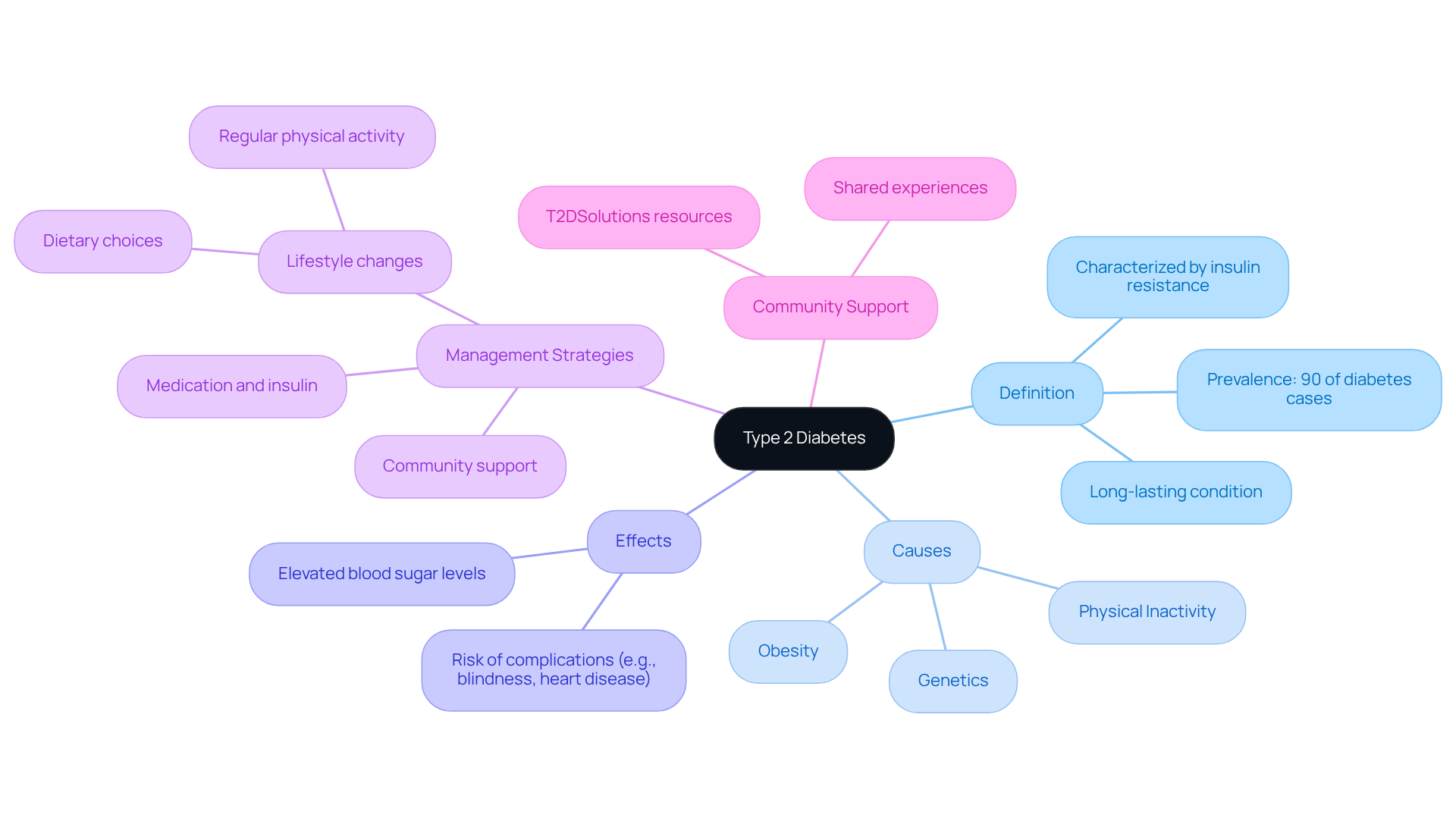
Identify Symptoms of Type 2 Diabetes
If you're experiencing increased thirst, frequent urination, fatigue, blurred vision, or slow-healing sores, you might be noticing common symptoms of Type 2 Diabetes. You may also feel hungrier than usual or experience unexplained weight loss. Recognizing these signs early is crucial, as a timely diagnosis can significantly improve your management outcomes. In fact, research shows that approximately 38.4 million people in the U.S. had diabetes in 2021, which represents 11.6% of the population. Sadly, many remain undiagnosed.
It's understandable to feel concerned if you find yourself thirstier than usual or needing to urinate more frequently. This could be a sign that it's time to consult a healthcare provider for a blood sugar test. Keeping a symptom diary can also be incredibly helpful. By tracking changes and patterns, you can have a more informed discussion with your doctor. Current expert opinions strongly emphasize the importance of being aware of these early signs. They can lead to prompt intervention and better health management.
With 8.7 million adults aged 18 years or older having undiagnosed diabetes, proactive monitoring of symptoms is essential. You're not alone in this journey. For additional details on managing these symptoms and understanding how do you control type 2 diabetes, T2DSolutions provides valuable resources and assistance. We are here to support you every step of the way.
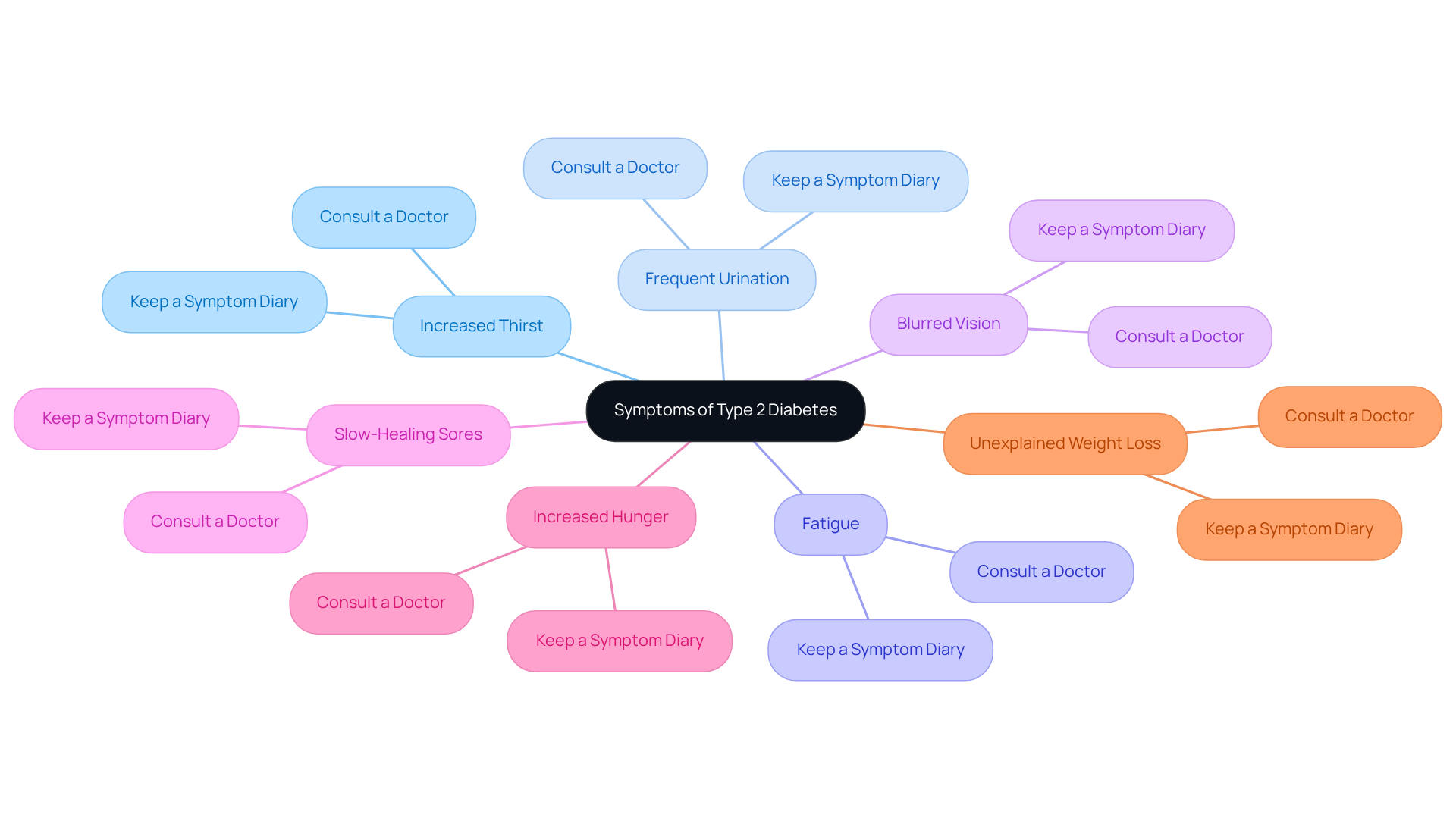
Implement Lifestyle Changes for Effective Management
To effectively manage Type 2 Diabetes, consider implementing the following lifestyle changes:
-
Adopt a Healthy Diet: Prioritize whole foods such as fruits, vegetables, whole grains, and lean proteins. It's important to limit processed foods, added sugars, and saturated fats. Including high-fiber foods can assist in reducing glucose and cholesterol levels. Remember, meal planning is essential for maintaining a balanced diet; it allows for mindful eating and portion control.
-
Increase Physical Activity: Aim for at least 150 minutes of moderate-intensity exercise each week. Activities such as walking, swimming, or cycling not only assist in reducing sugar levels but also improve insulin sensitivity. Engaging in resistance training at least twice a week is also recommended, as it can improve muscle strength and overall health.
-
Maintain a Healthy Weight: Even a modest weight reduction of 5-10% can significantly enhance sugar regulation. Set realistic weight loss goals and celebrate small achievements to stay motivated. Regular physical activity combined with a healthy diet is key to achieving and maintaining a healthy weight.
-
Manage Stress: It's understandable to feel overwhelmed, and chronic stress can negatively impact glucose control. Incorporate relaxation techniques such as yoga, meditation, or deep breathing exercises into your daily routine to help manage stress levels effectively.
-
Stay Hydrated: Drinking plenty of water throughout the day is crucial for regulating blood sugar levels. Staying hydrated can also help reduce hunger and support overall health.
By adopting these strategies, you're taking proactive steps toward managing your condition effectively, including knowing how do you control type 2 diabetes, leading to improved health outcomes and a better quality of life. Remember, T2DSolutions is dedicated to offering resources and assistance for individuals managing their health journey. We are here to support you every step of the way, ensuring you have the tools required for successful management.
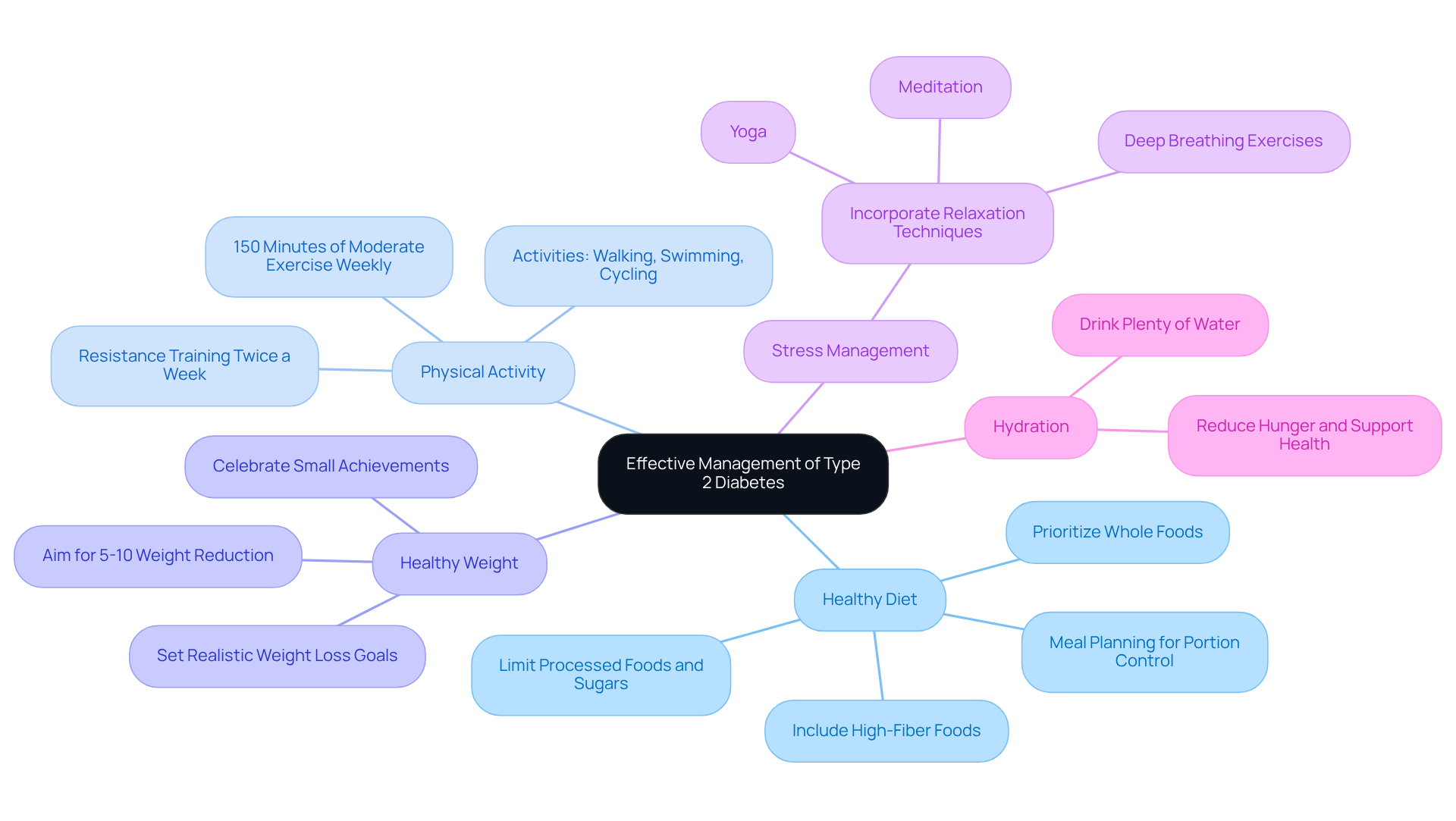
Utilize Medication and Treatment Options Wisely
Managing Type 2 Diabetes can feel overwhelming, but understanding how do you control type 2 diabetes means you're not alone in this journey. Medications for Type 2 Diabetes primarily include oral options like Metformin, which lowers blood sugar levels by enhancing insulin sensitivity and decreasing glucose production in the liver. Metformin continues to be the primary therapy for around 150 million people worldwide, showcasing its efficacy in controlling blood sugar levels. Other medications, such as sulfonylureas, DPP-4 inhibitors, and GLP-1 receptor agonists, are also available, each with unique mechanisms and benefits.
To understand how do you control type 2 diabetes, it's essential to follow your prescribed medications for effective blood sugar level management. Regular communication with healthcare providers about any side effects or concerns can lead to necessary adjustments in dosages or medication changes. For instance, studies show that patients who consistently adhere to their medication regimens experience better glycemic control and reduced complications.
Combining medication with lifestyle modifications—such as dietary changes and increased physical activity—is one approach to consider when asking how do you control type 2 diabetes to significantly enhance treatment effectiveness. Current opinions from endocrinologists emphasize the importance of a holistic approach, integrating medication with lifestyle adjustments to understand how do you control type 2 diabetes for optimal health outcomes. Remember, small changes can lead to significant improvements in your health.
As T2DSolutions launches as a new resource hub for health education, it will provide valuable support for you in managing your medication and lifestyle changes. Always consult your healthcare provider before making any changes to your medication regimen to ensure a tailored approach to your diabetes management. We are here to support you every step of the way.
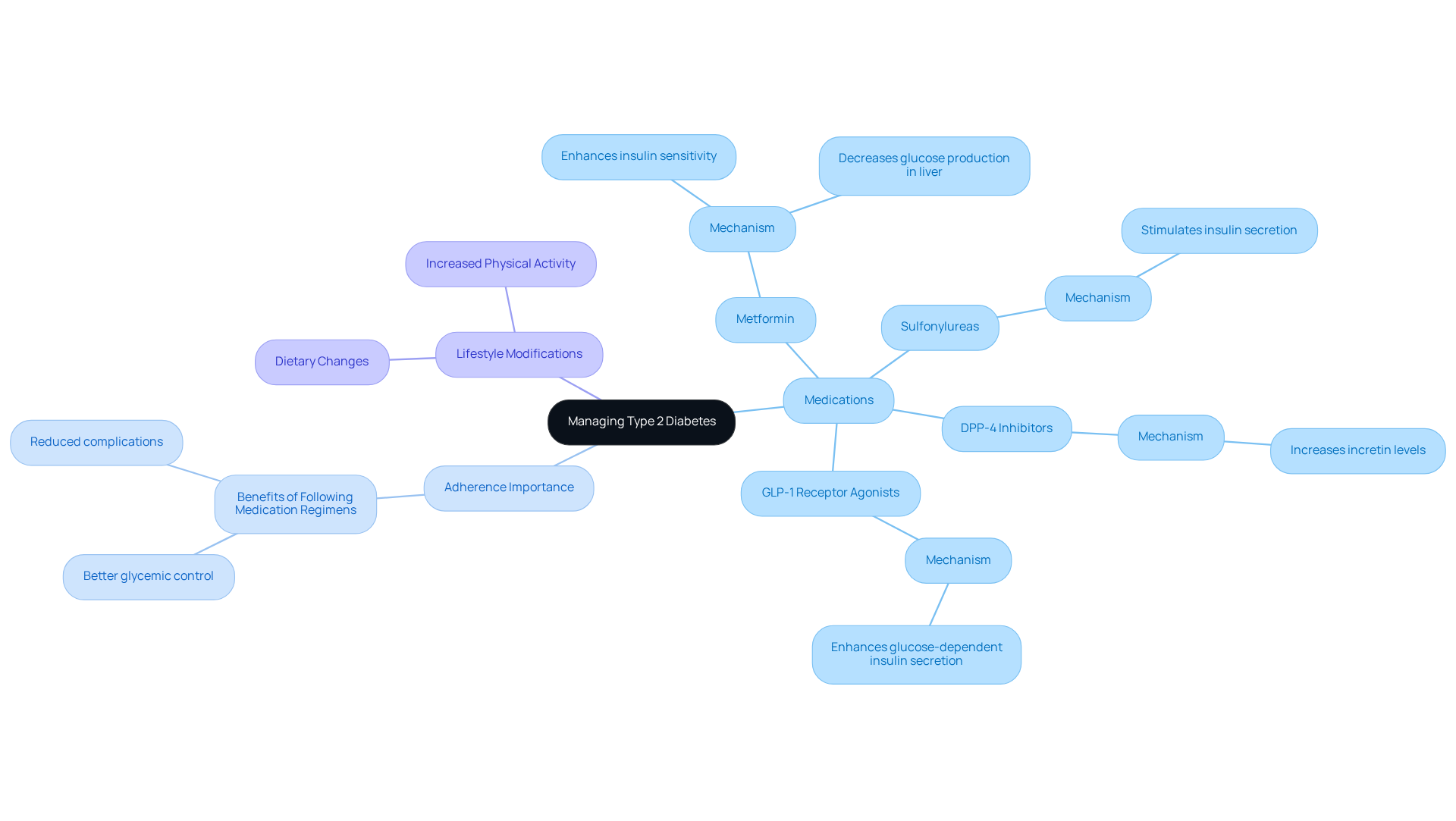
Monitor Blood Sugar Levels Regularly
Managing Type 2 Diabetes can feel daunting, but regular glucose monitoring is an essential part of your journey. It's important to use a glucose meter to check your levels at different times throughout the day, especially before meals and at night. Keeping a log of your readings can help you identify patterns and triggers that affect your blood sugar. Aim for the target ranges set by your healthcare provider—like a preprandial plasma glucose target of 80-130 mg/dL and an A1C target of less than 7% for most nonpregnant adults with diabetes. If you notice significant fluctuations, don't hesitate to discuss them with your healthcare team. Understanding these targets is crucial for effective management.
You might also consider continuous glucose monitors (CGMs) for real-time tracking. These devices provide immediate feedback on your glucose levels, and research shows that CGMs can improve glycemic control and enhance self-care behaviors, leading to better health outcomes. Remember, it's completely normal to experience intense feelings in response to your glucose readings, such as confusion or frustration. These emotions can impact your decision-making, so be gentle with yourself.
It's also important to recognize that access to CGMs may vary, especially for lower-income individuals and those on Medicaid. Understanding your glucose levels empowers you to make informed choices about your diet, exercise, and medication, which ultimately helps you learn how to control type 2 diabetes. And don't forget to check your urine for ketones when your blood glucose levels are high or if you're feeling unwell. You're not alone in this journey; we are here to support you every step of the way.
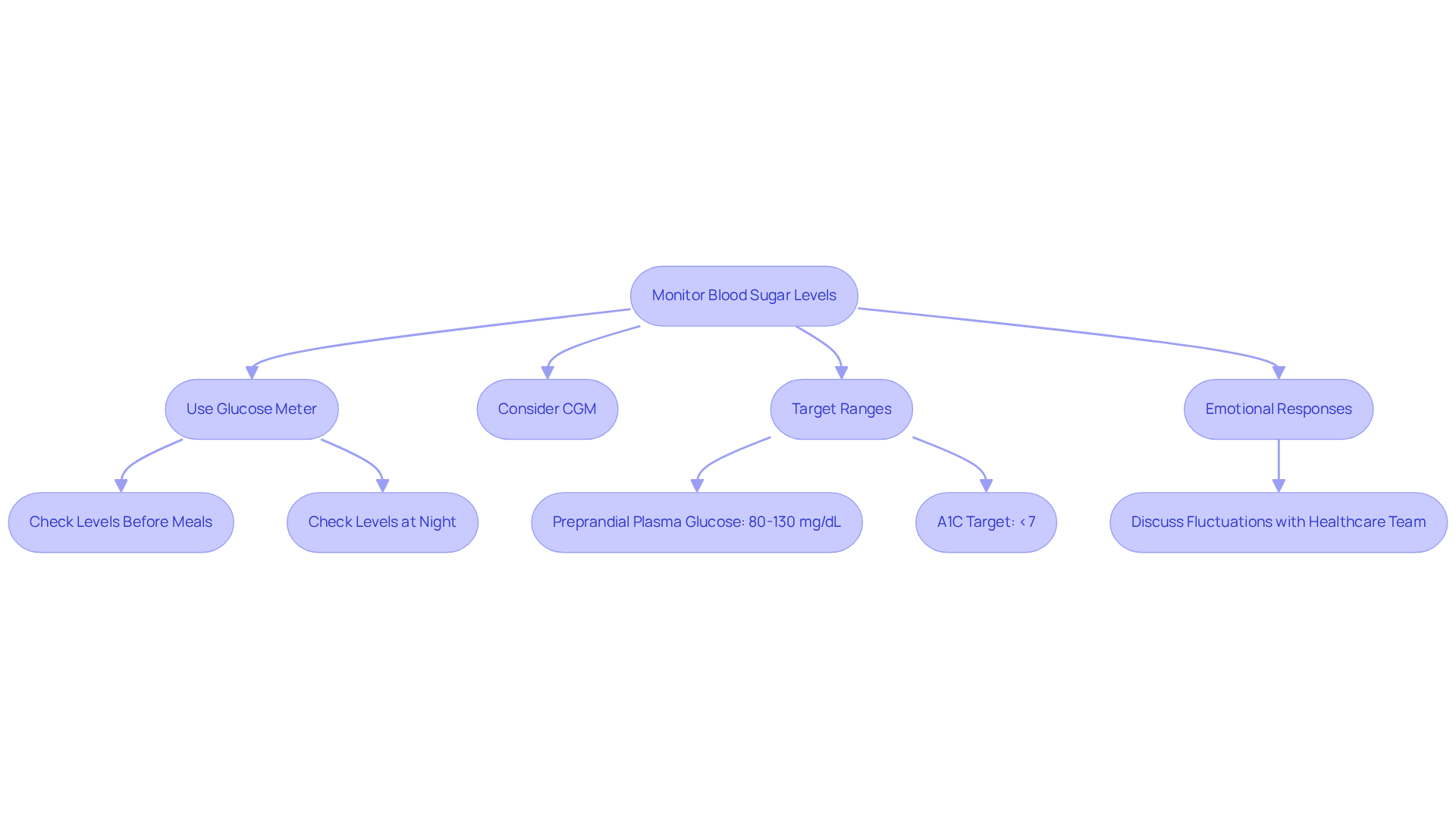
Conclusion
Understanding and managing Type 2 Diabetes is an empowering journey that involves recognizing the condition, identifying symptoms, and making informed lifestyle choices. It's understandable to feel overwhelmed, but this article emphasizes that Type 2 Diabetes, characterized by insulin resistance, can be effectively controlled through a combination of dietary changes, regular physical activity, medication adherence, and consistent blood sugar monitoring.
Key strategies discussed include:
- Adopting a healthy diet rich in whole foods
- Engaging in regular exercise
- Managing stress
- Staying hydrated
Remember, the importance of medication, such as Metformin, cannot be overlooked, as it plays a crucial role in controlling blood sugar levels. Regular monitoring of glucose levels is vital for understanding personal health patterns and making necessary adjustments to treatment plans.
Ultimately, the management of Type 2 Diabetes is a multifaceted approach that requires commitment and support. By implementing these key steps and utilizing available resources, individuals can take significant strides toward better health and improved quality of life. You're not alone in this journey; empowerment through knowledge and proactive measures is essential in the journey to control Type 2 Diabetes effectively. Embrace these changes and seek support from communities like T2DSolutions to navigate this path with confidence.
Frequently Asked Questions
What is Type 2 Diabetes and what causes it?
Type 2 Diabetes is a long-lasting condition characterized by insulin resistance, where the body struggles to use insulin efficiently, leading to elevated blood sugar levels. It is influenced by factors such as obesity, physical inactivity, and genetics.
How prevalent is Type 2 Diabetes?
Nearly 90% of individuals diagnosed with diabetes are identified as having Type 2 Diabetes, highlighting its widespread occurrence.
What role does obesity play in Type 2 Diabetes?
Obesity significantly increases the risk of developing insulin resistance, making weight management crucial for blood sugar regulation.
Can Type 2 Diabetes be reversed?
Yes, there are cases where individuals have successfully reversed Type 2 Diabetes through dedicated lifestyle changes, as demonstrated by a 62-year-old who achieved this in just 30 days.
What are common symptoms of Type 2 Diabetes?
Common symptoms include increased thirst, frequent urination, fatigue, blurred vision, slow-healing sores, increased hunger, and unexplained weight loss.
Why is it important to recognize the symptoms of Type 2 Diabetes early?
Early recognition of symptoms is crucial as it can lead to a timely diagnosis and significantly improve management outcomes.
How many people in the U.S. are affected by diabetes?
Approximately 38.4 million people in the U.S. had diabetes in 2021, representing 11.6% of the population, with many remaining undiagnosed.
What should I do if I notice symptoms of Type 2 Diabetes?
If you experience symptoms such as increased thirst or frequent urination, it’s advisable to consult a healthcare provider for a blood sugar test. Keeping a symptom diary can also be helpful for discussions with your doctor.
What resources are available for those diagnosed with Type 2 Diabetes?
T2DSolutions offers a holistic approach to diabetes care, encouraging lifestyle changes and providing community support for individuals newly diagnosed with Type 2 and Type 3 diabetes.



